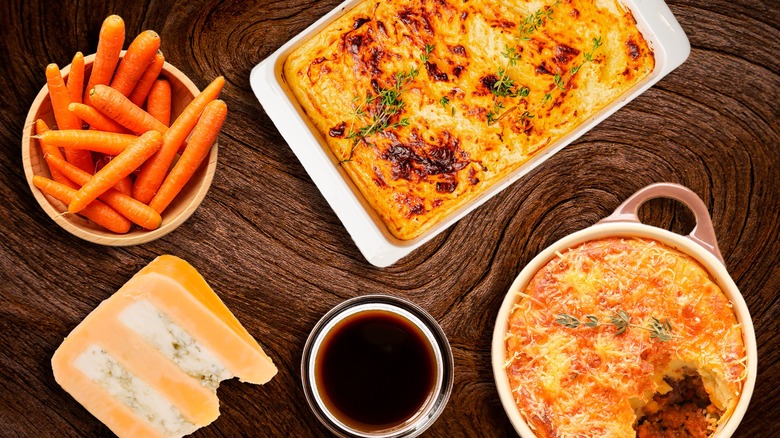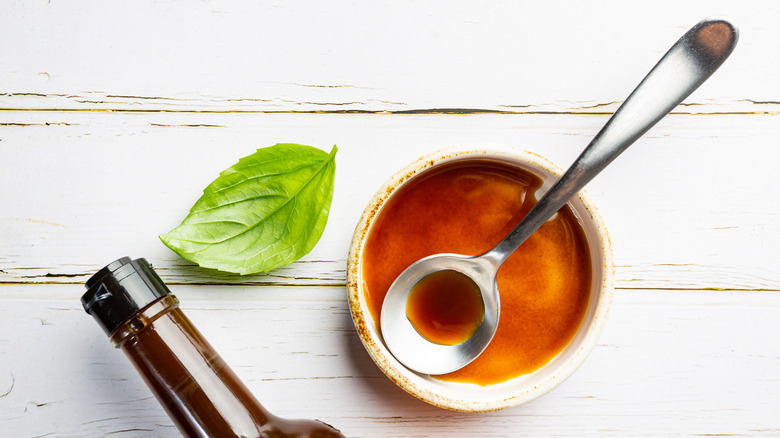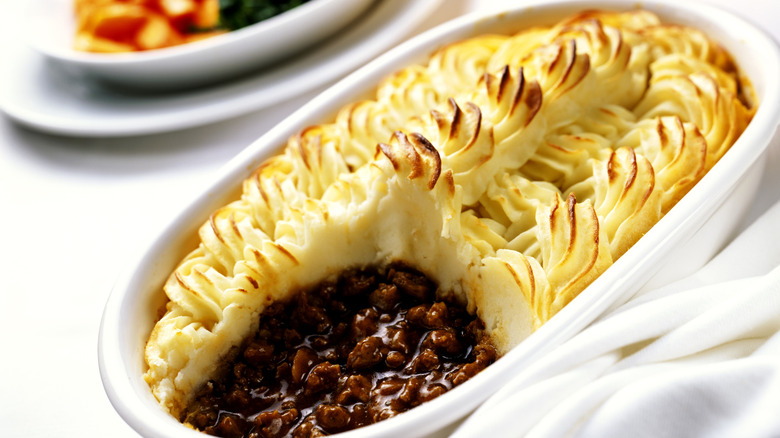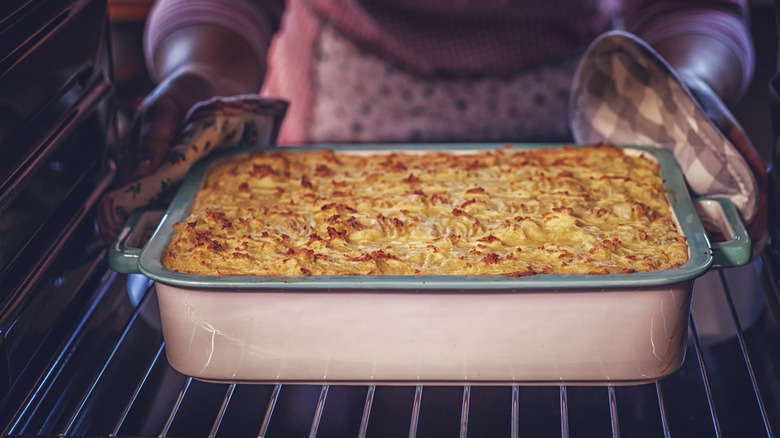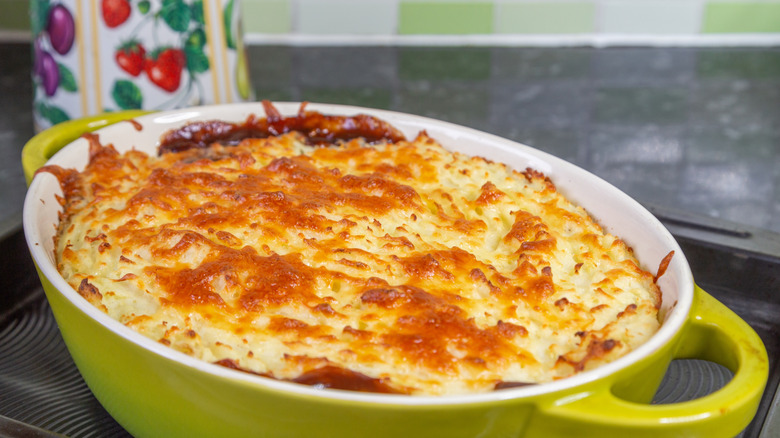13 Tips You Need To Cook An Unforgettable Shepherd's Pie
We may receive a commission on purchases made from links.
In the British Isles, wood-paneled pubs on cobbled roads are havens for shepherd's pie, the heartiest of comfort foods. With creamy mashed potatoes coating the top, and a savory gravy of ground meat and roasted vegetables on the bottom, this gloom-defying delicacy beats the blues every time. Yet if you're a novice chef, you might feel cowed by the prospect of cooking it from scratch. This casserole is not the average one-and-done dump dinner; it requires a bit of preparation and multiple steps — simmering a stew, and whipping up spuds — to pull off swimmingly.
Assuming you're trying to recreate the plate you tried in that hole-in-the-wall in Dublin, what can you do to transform a hum-drum dinner into something unforgettable? For now, you can put down your American Express Travel card, because restaurateurs at work in the U.S. can help level up your cooking goals in no time. Chowhound spoke with James Sawyer, executive chef at Ri Ra Irish Pub in Las Vegas, as well as Ashlee Gardner, owner of The Cat & Fiddle in Hollywood, to get the 411 on crafting the classic meal at home. Both specialize in authentic Irish cuisine, and years in the profession has cemented their expertise. So follow along for some sage advice (and excellent tricks) to impress your dinner guests every time.
1. Consider mixing beef and lamb
At this point, we should know the difference between shepherd's pie and cottage pie is in the meat. Lamb equals shepherd's pie, beef equals cottage pie, right? Yet from James Sawyer's experience, "all lamb can be a bit strong" for those not acclimated to the protein's gamier aromas. Home chefs, then, might consider cooking a mix of both when getting the base of their shepherd's pie underway. The Cat & Fiddle opts for a 60-to-40 beef-to-lamb blend, and according to Ashlee Gardner, this combination has endured for over 40 years because each variety contributes something special: "beef for the stability and the flavor of the lamb."
Visit your grocery store to see what cuts are on hand. Keep in mind most supermarkets have a butcher on site, who can weigh out exact portions of the proteins you need. Lamb tends to be pricier, and lacks the accessibility of ground beef, so if you decide to go down the cottage pie path, nobody will fault you for that. The most important thing, regardless of what you choose, is that your protein is fattier rather than too lean. Gardner suggests, "I think getting a medium content for beef like 80% should do," which is also the cook-approved ratio that's best for juicy burgers.
2. Season outside the box
It's one thing to frequently season the dish at each stage of the cooking process. It's another to unleash mouthwatering multitudes with just a sprinkle or dash of an unexpected spice. To heighten the taste of your homemade shepherd's pie, it's wise to experiment with seasonings you wouldn't normally think of. Salt, pepper, rosemary, and thyme define the herb-forward flavor in a traditional shepherd's pie, and there's nothing wrong with sticking to it. But if you limit the scope to what's only listed in your cookbook, you might rob your dish of mind-boggling tweaks to take it to the next level.
James Sawyer can attest to the benefits of branching out. He favors mild chili powder and paprika for a tinge of smokiness and fire, but if you have an expansive spice rack, feel free to tinker around. Cayenne can add a kiss of heat to your shepherd's pie, while cumin, although used in Mexican and Middle Eastern fare, complements the umami undertones to a surprising degree. In Los Angeles where The Cat & Fiddle resides, the dish comes alive with cinnamon, nutmeg, and even Cajun seasonings for a spicy jolt. Moral of the story? Don't rest on your laurels (or bay leaves): see what speaks to your palate and go from there.
3. Warm your dairy for a creamy mash
Spuds, the second component to shepherd's pie, play an equal part in making your pub worthy feast the talk of the dinner table. As such, the taters crowning your casserole should never taste dried-out or mealy. For this reason, it's essential to whip your potatoes to a light, fluffy consistency, and James Sawyer at Ri Ra swears by a technique that's particularly foolproof: he warms up the dairy when mashing the potatoes. This results in a supremely pleasant texture, in contrast to cold liquids that cause everything to cool down.
Sawyer first begins by gathering his dairy products. He uses cow's milk and butter, although it's very common to stir in sour cream or heavy cream, depending on what you prefer. As he instructs, "heat the milk and butter together until the butter has melted and the milk is hot but not boiling." Combining with the liquified cream, the hot potatoes yield to the rich proteins and form a whipped, airy texture. Additionally, shaking in salt and pepper keeps the flavor of the potatoes pronounced, so no blandness threatens to undermine your meaty masterpiece.
4. Never skip the Worcestershire sauce and tomato paste
Shepherd's pie is a stunner for hungry bellies, and not simply because it's the meatiest and potatoiest of meat-and-potato excellence. The savory feel, notably in the tangy aromas, is on behalf of condiments that have become essential assets: Worcestershire sauce and tomato paste. These components contribute a unique flair, lending depth and a nice counterbalance to the herbs and spices. Worcestershire sauce is prized for bumping up the savory character of meat-based dishes, as the astringent warmth is key to powering up the flavor. Tomato paste is another key feature, bringing tanginess and a glowing orange hue to the gravy.
Arguably the funky umami undertones define this casserole, and without them, the taste would mirror an ordinary beef stew — still devourable on a frigid January day, but not what comes to mind as the average pie. So how much is considered "just right" for your filling? You don't have to be too precise when measuring the quantities, but keep in mind you don't want either sauce to overpower the pie. Generally, 1 to 2 tablespoons of each will imbue your gravy with a good kick, but eyeballing the amount to a little more — or a little less — isn't a problem at all.
5. Boost the shepherd's pie with some surprise additions
Hearty (and hardy) ingredients give shepherd's pie its clout as a sustaining meal, sticking to the ribs and warming the soul. Bring out these qualities by mixing "surprise" elements into your rendition. Tinkering with add-ins to your filling never steers a culinary expert astray, and that's a fact. Whether it's a seemingly out-of-place sauce or a splash of good booze, you'll come out to the end with a livelier dish bursting with flavor. And you won't know what works unless you try it.
There's a couple tacks one can take with boosting the impact of the entree at hand, and we'll look to the cooking pros for these suggestions. Think Dijon mustard is only a sandwich topping? In shepherd's pie, the condiment is an instant transformer; it "adds depth and flavor" while maintaining the recipe's clarity, according to executive chef James Sawyer. Sawyer also notes the power of brown sugar for a sweeter permutation, albeit still complementary to the stronger essence of the spices. If you like a bit of potency, spike the gravy with a dark beer or red wine for a dry, floral bent.
6. Choose fresh vegetables
We know hand-chopping a bunch of veggies sounds like a slog to most of us short on cooking time – especially when the bagged kind are a step away on the shelf of your freezer. But procuring your garden provisions fresh, as noted by our experts, makes a tremendous difference on the final plate. True, taking a knife to raw vegetables is how peasants centuries prior did it, but non-frozen vegetables simply impart a fresher taste you'll find bypass the bland, "microwaved" feel. With the exception of peas, springing for fresh carrots, leeks, and onions is the way to go if you want to elevate the flavor. Ensure your vegetables are cut into evenly-sized pieces.
It's okay if your veggies have a little crunch, and may be preferable to counteract the soft ground meat. Should you prefer a softer treatment for your veggies, it's acceptable to roast them a little bit longer, just until a fork pierces through. Feel free to dump the vegetables into the pot at the same time, since sweating them together will draw out the individual aromas, and permeate into the mixture more thoroughly. James Sawyer advises tossing in the peas as the last step to finishing off the filling: "that way, they stay bright green and don't shrink."
7. Always deglaze the pan
Deglazing the pan is crucial for taking textbook shepherd's pie up a notch. When your meat is sautéing, it'll build up a crusty fond that emerges as the protein browns from the high temperature (aka, the Maillard reaction). Much like cooking pot roast, another wintertime workhorse, you'll want to scrape these charred bits off of the bottom so they have a chance to mingle with everything else simmering together. Your gravy will gain intensely delicious flavor as a result.
This tip involves dredging up the morsels with something wet. Water will suffice at bare minimum if nothing else. For the sake of making your pie unforgettable, you'd be doing yourself a favor by selecting a liquid that carries some kind of flavor with it. Think broth or stock. It can come in a can or box, and any flavor, from chicken and beef to vegetable, sweeps the pan equally well. Alternately, booze is a great for dislodging the particles and unleashing zing. Pour in a splash of red wine (your choice) to free the fond, or perhaps if you prefer a heartier quality you could reach for a dark beer. Porters and stouts remain great options for the above reasons, not to mention both go hand-in-hand with the dish's region of origin.
8. Cold mash can disrupt the shepherd's pie filling
Garnishing your shepherd's pie with the potatoes makes you one step closer to dining in Emerald Isle-fashion. But if you've noticed, cold mashed potatoes are a pain to work with. If the mash is cold, they'll congeal and wrench up the filling buried underneath as you spread them with your knife or spoon. Bakers who've ever iced a cake without completing a crumb-coating know how much of a nuisance this can be, and the same notion applies to shepherd's pie.
Avoid the streaky mess by making sure, at this juncture, that you dollop on the potatoes warm, rather than when they've lost heat. It gives the shepherd's pie "a smoother look," notes James Sawyer, who adds that it's "ultimately easier when prepping the dish to be served." Simply put, steaming spuds will glide on seamlessly and be less prone to clinging to the gravy.
Whether or not there's ground tidbits speckling the exterior won't really affect the quality of your cooking. That doesn't mean it ever hurts to put some thought into your casserole's presentation. Assure you follow this step, and we guarantee there's a memorable meal on the horizon for your guests.
9. Maximize browning by fluffing up the potatoes
Although a smooth sheet of potato looks pretty, shepherd's pie shines as a meal when the application is rustic — "rough around the edges," as they say. In fact, you maximize the golden crunch when the spuds are disheveled, since the oven sears the peaks of starch while the dish heats in the oven. So listen to the experts, and ditch the clean finish. Fluff and ruffle up the mashed potatoes in order for those edges to garner extra texture.
James Sawyer's method for locking in those delectable nooks and crannies is a piping bag, which sounds unusual. However, its function is pretty ingenious. This tool allows you to "frost" the surface of the pie with ease, and without getting your hands messy. A gallon freezer bag also works as a frugal kitchen hack. Sawyer chooses to squiggle out straight lines, but how you design the outside is up to your imagination. Ornate swirls, puffs, and blooms offer some aesthetic appeal in addition to aiding the browned crunch. Or, if you just want to keep it simple, grab a fork and brush in the lines to create texture that way.
10. Use the correct baking dish
Picture pulling your shepherd's pie casserole out of the oven and being greeted with greasy mush leaking down the dish. Should Vesuvius-level overflow constantly hamper your homespun efforts, it's probably a good idea to first check what bakeware you're using. Regardless of what cooking vessel you opt for, it needs to be big enough — and wide enough — to hold everything in without splattering. Remember, ample room is needed to pile in the gravy and potatoes, one on top of the other, so selecting your tray carefully is a must.
Your recipe will probably be the best guide when it comes to figuring out this portion of the process. Thankfully, a lot of kitchenware on the market is standardized, with measurements conforming to meet the common uses home chefs demand of it. Feeding a larger group, like family, makes 9x13-inch casserole dishes a safe bet, but you can also opt for a circular cast-iron pan – which in this case, can also be utilized for prepping the filling — streamlining the work of transferring the stew into a separate container when it's time to bake.
11. Try broiling the shepherd's pie
Most shepherd's pies you come across in a restaurant boast the brownest, bubbliest potato tops imaginable. A conventional oven will render good color on your casserole, but the 400 degrees Fahrenheit setting isn't adequate for torching the crust to that blackened state. Among the professionals, getting the coating super golden-brown can be achieved by broiling in addition to baking. "Using the broiler function in your at-home oven is key," James Sawyer says, and can transform a shepherd's pie that's simply okay into something spectacular and showstopping.
Now assuming you've wondered about the difference, broiling is definitely a separate beast to baking. The heat is heavily concentrated, as opposed to circulating throughout the appliance to warm the casserole all over. Unsurprisingly then, Sawyer confirms the step is best implemented as a final touch, once the dish has completed heating in the oven. This prevents overcooking the dish and possibly drying it out under the intense heat. Don't neglect to raise the rack, and adjust if needed, to get the crust to your liking. Just be sure not to leave it in for too long; two to three minutes is what Ashlee Gardner sticks with so it doesn't scorch by mistake.
12. Sprinkle on cheese for a decadent crust
What goes better together than creamy potatoes and cheese? There's no doubt adding cheese to your shepherd's pie excites the taste buds much more than a plain version. A decadent shepherd's pie crust can be gained from an array of wedges, gourmet, or bought from your trusted grocery store. Ri Ra's James Sawyer is a fan of sharp cheddar, and if you can snag an Irish import, all the better. Likewise, Ashlee Gardner sources English cheddar from Gloucester to top The Cat & Fiddle's pies. Gruyère is an enticing choice, since the funkier kick is balanced out by the mellower mash. Those who prefer a sharper-tasting cheese can try Italian varieties, like Parmesan or a potent pecorino Romano.
Regardless of what style you pick, it's a must to grate it yourself; pre-shredded cheeses are notorious for non-clumping agents, which make it much harder to melt than cheeses shaved off a block. And if the cheese is saltier, definitely account for that when flavoring the other elements of your dish (remember, you can't undo the seasoning once it's added). If you really want to double down on the indulgence factor, this should do the trick: fold the cheese into your potatoes for a blast of flavor.
13. Explore shepherd's pie variations
Authentic shepherd's pie is great, but this comforting dish has spawned countless variations as plentiful as they are tasty. Have you heard of "shepherd-less pie" before? This is probably the most common adaptation you'll hear about, as it's suitable for vegetarian and vegan diners alike. It's packed with the same robust aromas as the original meal, except you swap out the minced animal protein and simmer a bountiful array of vegetables in its place. Ubiquitous picks are mushrooms and lentils, yet parsnips, rutabagas, and other root vegetables channel the comforting vibes too.
Instead of russet or Yukon golds for your potato crust, try reinventing the wheel with earthy sweet potatoes. For the meat, ground turkey is great for a leaner take or chorizo if you crave gravy that's a little fiery. Hosting a dinner party? This is a great opportunity to serve sides with the entree, as diners do at The Cat & Fiddle, according to Ashlee Gardner.
It only makes sense that the recipe's versatility — how it's spiced, for one thing — extends seamlessly to shake-ups, creating a casserole that's inspired. Chefs are culinary whizzes, continuously honing their abilities through trial and error. Knowing rules can be broken opens the floodgates for deliciously unique spins.
